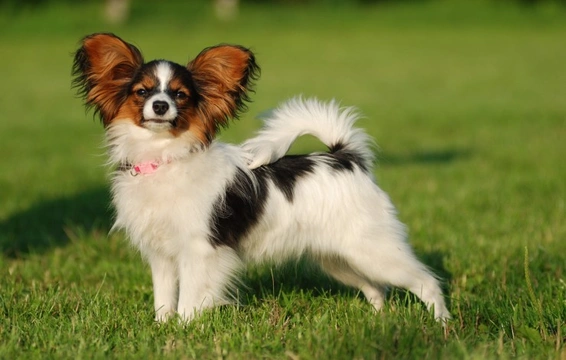
Neuroaxonal dystrophy DNA testing for the Papillon dog breed
The papillon is a very petite and finely boned little dog that has a delicate and almost ethereal appearance, thanks in large part to their large, highly feathered ears! It is in fact these ears that give the breed their name, as “papillon” is the French for “butterfly,” which the papillon’s ears are often said to resemble.
Papillon dogs are recognised in the UK within the Kennel Club’s toy group, and these small dogs make for very loving and affectionate little lap dogs and companions for people from all walks of life.
The papillon is a very bright and intelligent little dog that is very amenable to training and very quick to learn, but they are also quite a high energy breed (particularly for toy dogs) that need a lot of exercise as well as mental stimulation. Papillons are also quite high maintenance on the grooming front, but they are moderate rather than heavy shedders, so this is balanced out to a degree.
When it comes to papillon health, dogs of the breed tend to be quite long lived, with an average lifespan of between 13-15 years. However, there are a number of health issues that can sometimes be found within dogs of the breed, which are passed on from parent dogs to their young as hereditary health conditions.
Some of these can be identified by means of DNA testing, which not only allows the owner of a dog to find out their own dog’s status, but also the prospective status of any litter that they might have too. This means that DNA testing of parent dogs can hep to ensure that their litters have the best chances of themselves being healthy.
One hereditary health condition that can be found within the papillon breed that can be identified with DNA testing is called neuroaxonal dystrophy, and testing for this condition falls under the Kennel Club’s official testing scheme for the papillon b+reed.
In this article we will explain what neuroaxonal dystrophy in the papillon is, how it is inherited, and how to get a papillon DNA tested for the markers of neuroaxonal dystrophy. Read on to learn more.
What is neuroaxonal dystrophy in the papillon?
Neuroaxonal dystrophy is a hereditary health condition that first presents with symptoms in juvenile dogs. It causes affected dogs to display a number of neurological problems, such as behavioural problems and changes, and problems walking and moving normally.
Neuroaxonal dystrophy in the papillon is a progressive condition that tends to begin to show symptoms in dogs between the ages of six months and one year old. Initially, the condition usually presents with an unusual walking gait, and strange and out of character behaviours such as lethargy and a lack of interest in things going on, nervousness or fear responses, inappropriate barking or acting out, and potentially, an apparent loss of learned house training skills.
The physical symptoms of neuroaxonal dystrophy in the papillon include head tilting, pacing, vision problems, nystagmus of the eyes in some cases, and a loss of muscle tone. Affected dogs might also display out-of-character aggression or other significant behavioural problems.
How is papillon neuroaxonal dystrophy inherited?
Neuroaxonal dystrophy in the papillon dog is a hereditary condition, and a dog will only develop it if they inherit a certain combination of gene faults from their parents.
Papillon neuroaxonal dystrophy is inherited following the autosomal recessive model, which means that the combined genes inherited from both parent dogs (rather than just one) is what dictates any given dog’s status.
If you know the status of both parent dogs within any proposed mating match, you can predict the status of their offspring as follows:
- Two clear parent dogs will have a clear litter.
- Two affected parent dogs will have an affected litter.
- Two carrier parent dogs will produce a litter where pups can inherit any one of the three potential statuses; clear, carrier or affected. Pups bred from two carrier parents each have a 50% chance of also being a carrier, a 25% chance of being clear, and a 25% chance of being affected.
- Breeding a clear dog with an affected dog will produce a litter of carriers.
- Breeding a clear dog with a carrier will produce a litter within which each pup has a 50% chance of being a carrier and a 50% chance of being clear.
- Breeding an affected dog with a carrier will produce a litter within which each pup has a 50% chance of being affected, and a 50% chance of being a carrier.
How to get a papillon DNA test for neuroaxonal dystrophy
If you intend to breed from your papillon and want to provide puppy buyers with the reassurance of knowing that your parent stock is DNA tested and chosen with care to ensure that hereditary health issues aren’t passed onto the pups, both parent dogs in the mating match need to be tested.
To get a papillon DNA tested for the markers of neuroaxonal dystrophy, you just need to book a short appointment with your vet to allow them to take a DNA sample from your dog. This will then be sent off to one of the approved testing laboratories in the UK, who will return a result on the tested dog’s status.



